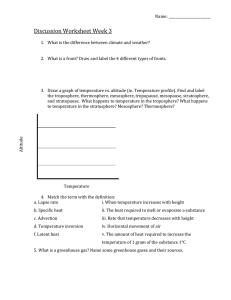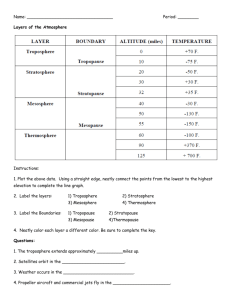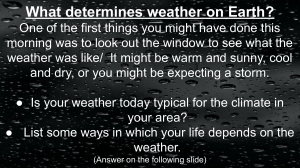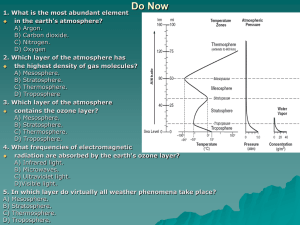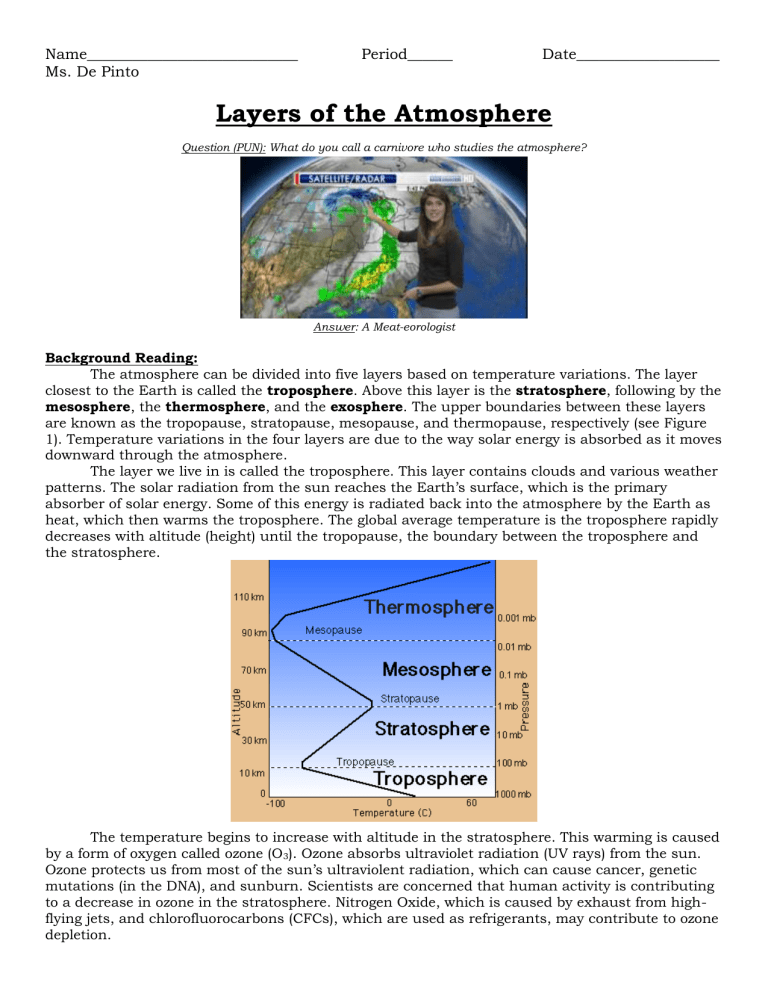
Name____________________________ Ms. De Pinto Period______ Date___________________ Layers of the Atmosphere Question (PUN): What do you call a carnivore who studies the atmosphere? Answer: A Meat-eorologist Background Reading: The atmosphere can be divided into five layers based on temperature variations. The layer closest to the Earth is called the troposphere. Above this layer is the stratosphere, following by the mesosphere, the thermosphere, and the exosphere. The upper boundaries between these layers are known as the tropopause, stratopause, mesopause, and thermopause, respectively (see Figure 1). Temperature variations in the four layers are due to the way solar energy is absorbed as it moves downward through the atmosphere. The layer we live in is called the troposphere. This layer contains clouds and various weather patterns. The solar radiation from the sun reaches the Earth’s surface, which is the primary absorber of solar energy. Some of this energy is radiated back into the atmosphere by the Earth as heat, which then warms the troposphere. The global average temperature is the troposphere rapidly decreases with altitude (height) until the tropopause, the boundary between the troposphere and the stratosphere. The temperature begins to increase with altitude in the stratosphere. This warming is caused by a form of oxygen called ozone (O3). Ozone absorbs ultraviolet radiation (UV rays) from the sun. Ozone protects us from most of the sun’s ultraviolent radiation, which can cause cancer, genetic mutations (in the DNA), and sunburn. Scientists are concerned that human activity is contributing to a decrease in ozone in the stratosphere. Nitrogen Oxide, which is caused by exhaust from highflying jets, and chlorofluorocarbons (CFCs), which are used as refrigerants, may contribute to ozone depletion. At the stratopause, the temperature decreases with altitude. At the mesopause, the temperature begins to increase with altitude, and this trend continues in the thermosphere. In the thermosphere, solar radiation hits the Earth’s atmosphere and begins to heat it. Because the air is so thin in this layer, a thermometer cannot measure the temperature accurately and special instruments are needed. Background Reading Questions: 1. What are the 4 layers of the atmosphere? 2. How is each layer divided? _________________________________________________________________ 3. Which layer do we live in and how is it heated? _____________________________________________ _______________________________________________________________ _______________________________________________________________ _______________________________________________________________ _______________________________________________________________ 4. What causes the stratosphere to be heated? ________________________________________________ _______________________________________________________________ _______________________________________________________________ 5. Aside from absorbing heat energy, what does the ozone layer do for us? _____________________ _______________________________________________________________ _______________________________________________________________ 6. What substances can destroy the ozone layer and where are the found? ____________________ _______________________________________________________________ _______________________________________________________________ _______________________________________________________________ 7. What are the tropopause, stratopause, mesopause, and thermopause? ______________________ _______________________________________________________________ _______________________________________________________________ 8. In which layer are the clouds contained? ___________________________________________________ ESRT Pg. 1 - Reading the Reference Table: 1. What is the hydrosphere? (Google this if you don’t know) ____________________________ ____________________________________________________________________________________ 2. What is the troposphere? (Use the reading in this packet to help you) _______________ ___________________________________________________________________________________ 3. What is the percent by volume of hydrogen in the hydrosphere? ___________________ 4. How much of the hydrosphere is oxygen? _________________________________ 5. What is the percent by volume of “other” elements in the hydrosphere? ____________ 6. What is the percent by volume of hydrogen in the troposphere? ____________________ 7. How much of the troposphere is Nitrogen? _________________________________ 8. What is the percent by volume of “other” elements in the troposphere? _____________ Beneath the atmosphere is the Geosphere. This includes the rocks and minerals that make up our solid portions of Earth. Let’s use the same ESRT chart (Pg. 1) to answer these questions: 9. What are the top three elements found in the Earth’s crust by mass? 10. Element: _____________________ Percent: _______________ Element: _____________________ Percent: _______________ Element: _____________________ Percent: _______________ What are the top three elements found in the Earth’s crust by volume? Element: _____________________ Percent: _______________ Element: _____________________ Percent: _______________ Element: _____________________ Percent: _______________
